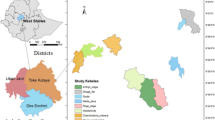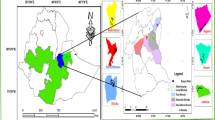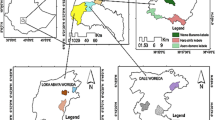Abstract
Forests in the highlands of Ethiopia have declined considerably, and the supply of forest-based ecosystem services is eroding. Managing agricultural landscapes as well as enhancing plant biodiversity in agro-ecosystems is and will continue to be one possible strategy to preserve biodiversity, ensure an ecosystem service supply and sustain agricultural productivity. This study investigated the current status and prospects of plant diversity and its determinants in an agricultural landscape dominated by smallholder farmers in Southern Ethiopia. Specifically, the study investigated effects of land use, altitudinal gradient, wealth status and household attributes on plant diversity in agricultural landscapes. A complete count, Y-frame transect sampling method and household interviews were used for the study involving 39 households and 115 sample plots. A total of 166 plant species belonging to 134 genera and 56 families were recorded in all land use types. Of these, 101 were woody plant species (51 trees and 50 shrubs), while 65 were cultivated herbs and grasses. Land use, altitude and household wealth status significantly influenced tree and shrub species richness. Among land uses, home gardens hosted the highest number of tree and shrub species. Upper altitudes and rich households also had the highest tree and shrub species richness compared to others. Plant diversity indices (Shannon, Simpson and Margalef) were affected by altitude, wealth status and land use types. Household location, wealth status, the household attributes of landholding and family size had strong and positive influences on the tree species diversity and woody stem density of households, while educational background and off-farm income were negatively related with household-owned tree stem density. Species preference ranking, seedling demand and importance value index computations indicated the dominance of exotic tree species, which may suggest their economic importance over indigenous tree species. In the long term, this might lead to dominance of exotic tree species in the landscapes, which could cause a potential future threat to the remnant indigenous plant diversity that is currently finding refuge in the agricultural landscapes.





Similar content being viewed by others
Notes
A kebele represents the smallest administrative unit in Ethiopia.
References
Abebe T (2005) Diversity in homegarden agroforestry systems of Southern Ethiopia. Dissertation, Wageningen University
Abebe T (2013) Determinants of crop diversity and composition in Enset-coffee agroforestry homegardens of Southern Ethiopia. Agric Rural Dev Trop Subtrop 114:29–38
Abebe T, Wiersum KF, Bongers F (2009) Spatial and temporal variation in crop diversity in agroforestry homegardens of southern Ethiopia. Agrofor Syst 78:309–322
Achalu N (2004) Farm forestry decision making strategies of the Guraghe households, southern-central highlands of Ethiopia. Dissertation, University of Dresden
Aerts R, Van Overtveld K, Haile M, Hermy M, Deckers J, Muys B (2006) Species composition and diversity of small Afromontane forest fragments in north Ethiopia. Plant Ecol 187:127–142. doi:10.1007/s11258-006-9137-0
Agidie A, Ayele B, Wassie A, Hadgu KM, Aynekulu E, Mowo J (2013) Agro forestry practices and farmers’ perception in Koga watershed, upper Blue Nile basin, Ethiopia. Agric For 59:75–89
Ango TG, Börjeson L, Senbeta F, Hylander K (2014) Balancing ecosystem services and disservices: smallholder farmers’ use and management of forest and trees in an agricultural landscape in southwestern Ethiopia. Ecol Soc 9(1):30. doi:10.5751/ES-06279-190130
Arnold JEM (1987) Economic considerations in agroforestry. In: Steppler HA, Nair PKR (eds), ICRAF, Nairobi, pp 173–189
Asfaw Z, Ågren IG (2007) Farmers’ local knowledge and topsoil properties of agroforestry practices in Sidama, Southern Ethiopia. Agrofor Syst 71:35–48. doi:10.1007/s10457-007-9087-0
Baral SK, Malla R, Khanal S, Shakya R (2013) Trees on farms: diversity, carbon pool and contribution to rural livelihoods in Kanchanpur District of Nepal. Banko Janakari 23:1–11. doi:10.3126/banko.v23i1.9462
Bekele AT (2007) Useful trees and shrubs of Ethiopia. ICRAF, Nirobi, pp 1–550
Boffa JM, Turyomurugyendo L, Barnekow-Lillesø JP, Kindt R (2005) Enhancing farm tree diversity as a means of conserving landscape-based biodiversity. Mt Res Dev 25:212–217
Boffa JM, Kindt R, Katumba B, Jourget JG, Turyomurugyendo L (2008) Management of tree diversity in agricultural landscapes around Mabira Forest Reserve, Uganda. Afr J Ecol 46:24–32
CRGE (2010) Ethiopia’s climate-resilient green economy green economy strategy, Addis Ababa
Dessie G (2007) Forest decline in south central Ethiopia extent, history and process. Dissertation, Stockholm University
Duguma LA, Hager H (2009) Forest products scarcity perception and response by tree planting in the rural landscapes: farmers’ views in central highlands of Ethiopia. Ekológia 28(2):158–169. doi:10.4149/ekol_2009_02_158
Duguma LA, Hager H (2010) Woody plants diversity and possession, and their future prospects in small-scale tree and shrub growing in agricultural landscapes in central highlands of Ethiopia. Small Scale For 9:153–174. doi:10.1007/s11842-009-9108-0
Edwards S, Kelbessa E (1999) Forest genetic resources of Ethiopia: status and proposed actions. In: Edwards S, De-missie A, Bekele T, Haase G (eds) The national forest resources conservations strategy development workshop. Proceedings of national workshop from 21–22 June 1999 held in Addis Ababa. Institute of Biodiversity Conservation and Research (IBCR), GTZ, Addis Ababa, pp 101–133
ENMSA (2015) Ethiopian National Meteorological Services Agency Unpublished Rainfall and Temperature data
Food and Agricultural Organisation of the United Nations (FAO) (1994) Provisional soil map of Ethiopia. Land Use Planning Project, Addis Ababa
Food and Agricultural Organization of the United Nations (FAO) (2010) Global forest resource assessment. Country Report Ethiopia. Fra 2010/065. FAO, Rome
Garrity D, Verchot L (2008) Meeting challenges of climate change and poverty through agroforestry. World Agroforestry Centre, Nairobi
Hadgu MK (2008) Temporal and spatial changes in land use patterns and biodiversity in relation to farm productivity at multiple scales in Tigray, Ethiopia. Doctoral Dissertation, Wageningen University
Hadgu KM, Rossing WA, Kooistra L, Van Bruggen AHC (2009) Spatial variation in biodiversity, soil degradation and productivity in agricultural landscapes in the highlands of Tigray, northern Ethiopia. Food Secur 1:83–89
Hailu H, Asfaw Z (2011) Homegardens and agrobiodiversity conservation in Sabata town, Oromia Regional State, Ethiopia. SINET Ethiop J Sci 34(1):1–16
Henry M, Tittonell P, Manlay RJ, Bernoux M, Albrecht A, Vanlauwe B (2009) Biodiversity, carbon stocks and sequestration potential in aboveground biomass in smallholder farming systems of western Kenya. Agric Ecosyst Environ 129:238–252
Holden S, Benin S, Shiferaw B, Pender J (2003) Tree planting for poverty reduction in less-favoured areas of the Ethiopian highlands. Small Scale For Econ Manag Policy 2:63–80
Hurni H (2007) Challenges for sustainable rural development in Ethiopia. Faculty of Technology, Addis Abeba University, Addis Abeba
SPSS Inc (2006) Statistical package for social sciences for windows. Release 20.0.0. SPSS Inc., Chicago
Jagger P, Pender J (2003) The role of trees for sustainable management of less-favored lands: the case of eucalyptus in Ethiopia. For Policy Econ 5:83–95
Jarvis DI, Myer L, Klemick H, Guarino L, Smale M, Brown AHD, Sadiki M, Sthapit B, Hodgkin T (2000) A training guide for in situ conservation on-farm. Version 1. International Plant Genetic Resources Institute, Rome
Kebede M, Kanninen M, Yirdaw E, Lemenih M (2013) Vegetation structural characteristics and topographic factors in the remnant moist Afromontane forest of Wondo Genet, south central Ethiopia. For Res 24(3):419–430
Kindt R, Simons AJ, Van Damme P (2004) Do farm characteristics explain differences in tree species diversity among western Kenyan farms? Agrofor Syst 63:63–74
Kindu M, Schneider T, Teketay D, Knoke T (2013) Land use/land cover change analysis using object-based classification approach in Munessa-Shashemene landscape of the Ethiopian highlands. Remote Sens 5:2411–2435. doi:10.3390/rs5052411
Kindu M, Schneider T, Teketay D, Knoke T (2015) Drivers of land use/land cover changes in Munessa-Shashemene landscape of the south-central highlands of Ethiopia. Environ Monit Assess 187:452
Kindu M, Schneider T, Teketay D, Knoke T (2016) Changes of ecosystem service values in response to land use/land cover dynamics in Munessa-Shashemene landscape of the Ethiopian highlands. Sci Total Environ 547:137–147
Lemenih M (2010) Growing eucalypts by smallholder farmers in Ethiopia. In: Gil L, Tadesse W, Tolosana E, Lopez R (eds) Proceedings of the Conference on Eucalyptus Species Management, History, Status and Trends in Ethiopia, Addis Ababa, Ethiopia, 15–17 September 2010. Ethiopian Institute of Agricultural Research (EIAR), Addis Ababa, Ethiopia, pp 91–103
Lemenih M, Kassa H (2014) Re-greening Ethiopia: history, challenges and lessons. Forests 5:1896–1909
Lemenih M, Teketay D (2006) Changes in soil seed bank composition and density following deforestation and subsequent cultivation of a tropical dry afromontane forest, Ethiopia. Trop Ecol 47(1):1–12
Lemmesa D, Kristoffer H, Peter H (2013) Composition of crops and land-use types in relation to crop raiding pattern at different distances from forests. Agric Ecosyst Environ 167:71–78
Magurran AE (1988) Ecological diversity and its measurement. Croom Helm, London
Mengesha B (2010) Alternative technologies for sustainable agricultural production and agroecosystem conservation in Arsi highlands, southeastern Ethiopia. Dissertation, Addis Ababa University
Mengistu F (2008) Fruit tree species in the wild and in homegarden agroforestry: species composition, diversity and utilization in western Amhara region, Ethiopia. Dissertation, Boku University
Millennium Ecosystem Assessment (2005) Ecosystems and human well-being: synthesis. Island Press, Washington, DC
Nair PKR (1993) An introduction to agroforestry. Kluwer Academic Publisher, Dordrecht
National Meteorological Services Agency of Ethiopia (2015) National Meteorological Services Agency of Ethiopia, Addis Ababa
Negash M (2007) Trees management and livelihoods in Gedeo’s agroforests, Ethiopia. For Trees Livelihoods 17:157–168
Negash N (2013) The indigenous agroforestry systems of the south-eastern Rift Valley escarpment, Ethiopia: their biodiversity, carbon stocks, and litterfall. Dissertation, University of Helsinki
Negash M, Yirdaw E, Luukkanen O (2012) Potential of indigenous multistrata agroforests for maintaining native floristic diversity in the south-eastern Rift Valley escarpment, Ethiopia. Agrofor Syst 85:9–28. doi:10.1007/s10457-011-9408-1
Ranganathan J et al (2008) Ecosystem services: a guide for decision makers. World Resources Institute, Washington, D.C.
Senbeta F, Denich M (2006) Effects of wild coffee management on species diversity in the Afromontane rainforests of Ethiopia. For Ecol Manag 232:68–74
Shannon CE (1949) The mathematical theory of communication. University of Illinois Press, Urbana
Shaxson L, Tauer LW (1992) Intercropping and diversity: an economic analysis of cropping patterns on smallholder farms in Malawi. Exp Agric 28:211–228
Snowdon P, Raison J, Keith H, Ritson P, Grierson P, Adams M, Montagu K, Bi HQ, Burrows W, Eamus D (2002) Protocol for sampling tree and stand biomass. National carbon accounting system, technical report no. 31. Australian Greenhouse Office, Canberra
Tadesse G (2001) Land degradation: a challenge to Ethiopia. Environ Manag 27(6):815–824
Tadesse G, Zavaleta E, Shennan C (2014a) Coffee landscapes as refugia for native woody biodiversity as forest loss continues in southwest Ethiopia. Biol Conserv 169:384–391
Tadesse G, Zavaleta E, Shennan C, FitzSimmons M (2014b) Prospects for forest-based ecosystem services in forest-coffee mosaics as forest loss continues in southwestern Ethiopia. Appl Geogr 50:144–151
R Development Core Team (2010) A language and environment for statistical computing. R Foundation for Statistical Computing Vienna, Austria. http://www.R-project.org/
R Development Core Team (2012) R: a language and environment for statistical com-puting. R Foundation for Statistical Computing. Vienna. ISBN 3-900051-07-0. http://www.R-project.org/. Accessed 30 Sep 2013
Tefera B, Ruelleb ML, Asfaw Z, Abraha BT (2014) Woody plant diversity in an Afromontane agricultural landscape Debark District, northern Ethiopia. For Trees Livelihoods. doi:10.1080/14728028.2014.942709
Teketay D (2001) Deforestation, wood famine, and environmental degradation in Ethiopia's highland ecosystems: urgent need for action. Northeast Afr Stud 8(1):53–76. doi:10.1353/nas.2005.0020
Teketay D, Lemenih M, Bekele T, Yemshaw Y, Feleke S, Tadesse W, Moges Y, Hunde T, Nigussie D (2010) Forest resources and challenges of sustainable forest management and conservation in Ethiopia. In: Bongers F, Tennigkeit T (eds) Degraded forests in Eastern Africa: management and restoration. Earthscan, London, pp 19–64
Telila H, Hylander K, Nemomiss S (2015) The potential of small Eucalyptus plantations in farmscapes to foster native woody plant diversity: local and landscape constraints. Restor Ecol 23(6):918–926. doi:10.1111/rec.12257
Tolera M, Asfaw Z, Lemenih M, Karltun E (2008) Woody species diversity in a changing landscape in the south-central highland of Ethiopia. Agric Ecosyst Environ 128:52–58. doi:10.1016/j.agee.2008.05.001
Yirdaw E, Starr M, Negash M, Yimer F (2015) Influence of topographic aspect on floristic diversity, structure and treeline of Afromontane cloud forests in the Bale Mountains Ethiopia. For Res 26(4):919–931. doi:10.1007/s11676-015-0155-4
WARD (2013) Woreda Rural Redevelopment unpublished annual Report
WARD (2015) Woreda Rural Redevelopment Report unpublished annual Report
Zomer RJ, Trabucco A, Coe R, Place F (2009) Trees on farm: analysis of global extent and geographical patterns of agroforestry. ICRAF Working Paper no. 89. World Agroforestry Centre, Nairobi
Acknowledgements
We owe a particular debt of gratitude to the farmers around the Butajira area who kindly allowed us to use their fields for samples. Special thanks go to our friends Habte Telila and Kiflu Gudeta, who were helpful in utilizing the GIS and R software programs, respectively. We also thank Addis Ababa University for financial support.
Author information
Authors and Affiliations
Corresponding author
Electronic supplementary material
Below is the link to the electronic supplementary material.
Rights and permissions
About this article
Cite this article
Haile, G., Lemenih, M., Senbeta, F. et al. Plant diversity and determinant factors across smallholder agricultural management units in Central Ethiopia. Agroforest Syst 91, 677–695 (2017). https://doi.org/10.1007/s10457-016-0038-5
Received:
Accepted:
Published:
Issue Date:
DOI: https://doi.org/10.1007/s10457-016-0038-5




